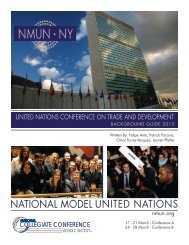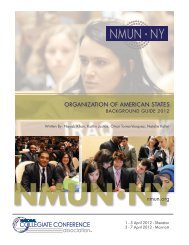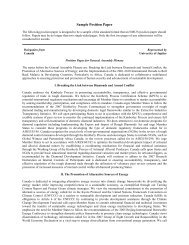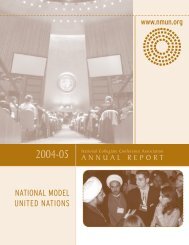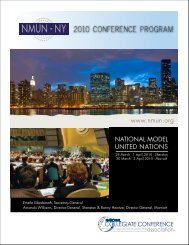UNFPA Background Guide - National Model United Nations
UNFPA Background Guide - National Model United Nations
UNFPA Background Guide - National Model United Nations
You also want an ePaper? Increase the reach of your titles
YUMPU automatically turns print PDFs into web optimized ePapers that Google loves.
Access to Sexual and Reproductive Health Care in Conflict Zones<br />
Refugees of conflict- or emergency-torn countries - are exceptionally vulnerable in all aspects, but this does not<br />
constitute a reason to put sexual and reproductive care aside while tending to other problems. 114 Instead, SRH care<br />
should be provided in tandem with provision of emergency shelter, food, and medicine. 115 Not only does this service<br />
the women who come to be refugees while pregnant or as new mothers, but also women who are in danger of sexual<br />
and gender-based violence based on their life circumstances. 116 In a review of the reproductive health of women<br />
affected by war, author McGinn points out “Conditions of refugee life are particularly conducive to sexual violence,<br />
both in the early stages of a complex emergency, when rape is used by armies as a weapon of war, and later in the<br />
stable phase, when violence perpetrated by intimate partners or acquaintances may become more prevalent.” 117<br />
While ensuring quality access to contraceptives and maternal health care is essential anywhere, it can be too easy to<br />
focus on the settled, more predictable environments, when refugee women have as much, or greater, need for such<br />
attention. 118<br />
The Role of Sexual and Gender-based Violence (SGBV)<br />
Women who have been physically or sexually abused experience an increased risk for unwanted pregnancy, STIs,<br />
and unhealthy or unsafe pregnancies. 119 Violence of this nature can be defined to include the following acts, all<br />
directed toward women and girls specifically because of their gender: domestic abuse; “sexual assault, dowryrelated<br />
murder, marital rape, selective malnourishment of female children, forced prostitution, female genital<br />
mutilation, and sexual abuse of female children;” verbal or physical force; humiliation or “deprivation of liberty …<br />
that perpetuates female subordination.” 120 The unwanted or unsafe pregnancies and the threatening environment that<br />
situations or locations where SGBV is rampant provide is a direct threat to maternal health and must be considered<br />
as a public health priority in the post-2015 agenda.<br />
Many factors can contribute to the perpetuation of SGBV, which broadly includes personal and sociocultural<br />
reasons for subjugating women. 121 One shocking statistic illustrates that SGBV disables or takes the lives of as many<br />
women aged 15 to 44 as cancer. 122 Coupled with a rate of 70% of women who experience violence in their lifetimes,<br />
it is clear this problem is inexcusably prevalent and unavoidable in the post-2015 health agenda. 123 Health care<br />
providers can play a crucial role in identifying threatened and/or abused women when properly trained to see the<br />
signs and empower the affected woman. 124 The role of the medical provider is intimate yet safe, an environment an<br />
abused woman likely does not have elsewhere, so such professionals can be a point of trust for women to seek<br />
support and even information about legal recourse. 125<br />
Engaging the Next Generation to Prevent Sexual and Gender-based Violence<br />
Incorporating a youth perspective for engagement in the post-2015 maternal health agenda will be necessary, as this<br />
segment of the population is rapidly growing – and no change can be sustainable without buy-in from those who will<br />
be charged with continuing to improve conditions for mothers around the world. Indeed, “stereotyping of gender<br />
roles and gender based discrimination begins in childhood, so efforts to support gender equality must start there, by<br />
addressing the roles of girls and boys and men and women in the household.” 126 Empowering women with education<br />
allows them to take charge in decision-making and resist or fight the system of abuse. 127 Educated women are able<br />
to recognize the problem with domestic abuse and societal discrimination and are better equipped to challenge the<br />
114<br />
Casey, Mitchell & Amisi, Haliza, et. al., Use of Facility Assessment Data to Improve Reproductive Health Service Delivery in<br />
the Democratic Republic of the Congo, 2009, p.2.<br />
115<br />
Ibid.<br />
116<br />
McGinn, Reproductive Health of War-Affected Populations: What Do We Know?, 2000, p.179.<br />
117<br />
Ibid.<br />
118<br />
Ibid.<br />
119<br />
Heise, Ellsberg & Gottmoeller, A Global Overview of Gender-Based Violence, 2002, p. S5.<br />
120<br />
Ibid., p. S6.<br />
121<br />
Ibid., p. S7.<br />
122<br />
7 Billion Actions, The World at Seven Billion: Top Issues – Fact Sheets [Website], 2011, p. 4.<br />
123<br />
Ibid.<br />
124<br />
Heise, Ellsberg & Gottmoeller, A Global Overview of Gender-Based Violence, 2002, p. S11.<br />
125<br />
Ibid.<br />
126<br />
7 Billion Actions, The World at Seven Billion: Top Issues – Fact Sheets [Website], 2011, p. 7.<br />
127<br />
Ibid., p. 9<br />
16




